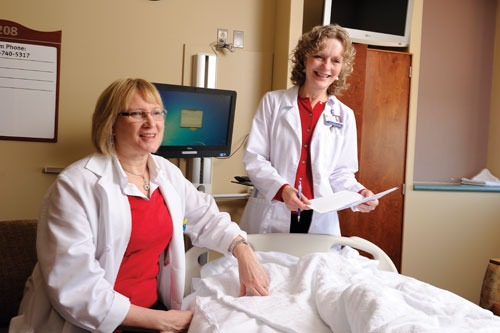Nurses Decrease Readmissions, Empower Patients
by Jennifer L.W. Fink
 In 2011, Nilda Crespo de Ortiz was admitted to Howard County General Hospital 14 times. In 2012, she experienced only three hospitalizations, despite her advanced age and multiple illnesses. The difference? A roundtable discussion of her needs and extensive follow-up coordinated by Francie Black, RN, CRNP, and Katherine Dysland, RN.
In 2011, Nilda Crespo de Ortiz was admitted to Howard County General Hospital 14 times. In 2012, she experienced only three hospitalizations, despite her advanced age and multiple illnesses. The difference? A roundtable discussion of her needs and extensive follow-up coordinated by Francie Black, RN, CRNP, and Katherine Dysland, RN.
Black is a geriatric nurse practitioner with the Acute Care for Elders (ACE) program at Howard County General Hospital. The program provides high-quality, developmentally and physically appropriate care to elderly patients so that they are able to return home after hospitalization. Black works with patients and staff every day to encourage physical movement and tackle obstacles that block patients’ safe return home. She often collaborates with Dysland, a patient transition guide who works for the Howard County Office on Aging.
“We both look at readmissions data every day,” Black says. “We look for patients who return over and over
again and target those patients to see what’s causing them to come back. We approach it in a proactive way; we focus on what we can do to help them return home safely and educate them on how they can take care of themselves and avoid readmission.”
Crespo de Ortiz, who was admitted more than once a month in 2011, definitely caught their eye. Together, Black and Dysland discussed ways to help her, as she navigated end-stage renal disease, and her son, who was also dealing with an ill father.
“Ultimately, we decided to hold a team meeting, to get everyone around a table to brainstorm how we could help this particular patient and family,” Black says. The team included Black and Dysland, Crespo de Ortiz and her son, her primary care provider, the hospitalist, social workers, a dietician, physical therapists, a pharmacist, a cardiologist, and an interpreter.
Together the group talked through issues that affected her care. They realized that Crespo de Ortiz, who was on a fluid restriction, was sneaking drinks of water, which threw off her fluid balance. “It took the cardiologist to say, ‘hey, we’re restricting her so much, we’re not giving her a reason to live.’ We ended up drawing down her fluid levels more during her weekly dialysis treatments, so she could drink more and eat the things she enjoyed,” Dysland says.
“Kathy also did a wonderful job of pulling together a whole notebook for the son, with a list of his mother’s medications, some educational info, a follow-up contact list and community resource information,” Black says. “She also helped the son get a Medicaid application and helped him get resources to build a ramp at the patient’s home.”
Through their cooperative efforts, Crespo de Ortiz was able to spend most of 2012 in the comfort of her own home. “The philosophy of our County is to help our elders age in place,” Dysland says. “I love our ability to tailor the care plan to the individual patient and family.”